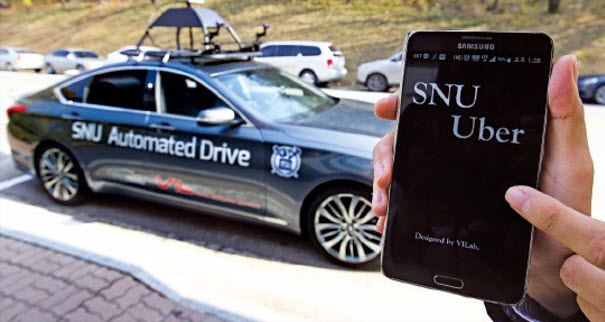
The SNUber taxi and its mobile app
On November 4, 2015, Seoul National University (SNU) Vehicle Intelligence Laboratory demonstrated SNUber, the first automated taxi service in Korea. Led by Professor SEO SeungWoo (Department of Electrical and Computer Engineering), the trial performance took place along a 4km route of the circulation beltway within Gwanak campus.
The name"SNUber" was coined by compounding"SNU" and"Uber." As this naming suggests, SNUber is very similar to the existing Uber service that connects taxis and customers through mobile apps, except that it uses automated, driverless vehicles. The core mechanism behind SNUber is a high precision 3D mapping technology that allows the car to become aware of its surroundings and predict the pathways of other nearby vehicles. Cameras and sensors installed all over the car calculate the location of any obstacles within 50-80 meters front and back, so that SNUber can avoid collisions. In addition, it can change lanes or overtake other vehicles by checking the adjacent lane. With the exception of unusual emergency situations where a pedestrian abruptly runs into the car, SNUber aptly operates its steering wheel, accelerator and brake.
During the trial performance, the SNUber taxi arrived in less than five minutes after the"Request a Ride" button was pressed on the mobile app. When students from the SNU Vehicle Intelligence Laboratory pressed the departure button after getting in the car, SNUber began driving itself along the previously designated route from the Institute of New Media and Communications to the Administration building.
Although the circulation beltway in the campus was a four-lane road with many curves, SNUber showcased fairly smooth driving techniques that were not much different from cars with human drivers. SNUber kept its speed under 30km/h, the limit inside the campus, and followed all traffic rules. When it encountered any obstacles, such as the school shuttle bus heading towards its direction, SNUber stopped temporarily to alter its path. On the backside of the driver's seat, a monitor screen displayed information of obstacles identified by camera sensors. The locations of other vehicles, pedestrians or bicycles that happened to come near SNUber were marked with a green box on the screen. After reaching the Administration Building and the requested ride was completed, the automated taxi moved off to its next destination.
SNUber's trial performance was very successful, as the automated taxi completed its designated route without any accidents. However, the actual commercialization of the service will need several more years of preparation. Professor Seo, Director of the SNU Vehicle Intelligence Laboratory, expressed that"limited commercialization may be possible by 2020." He added that"the artificial intelligence necessary for a completely automated Uber service would be developed around 2035."
• SNU Vehicle Intelligence Laboratory (Director Professor SEO SeungWoo): http://vi.snu.ac.kr/xe/
• SNU Department of Electrical and Computer Engineering: http://ee.snu.ac.kr/en
Written by YOON Jiwon, SNU English Editor, jiwonyoon@snu.ac.kr
Reviewed by Eli Park Sorensen, SNU Professor of Liberal Studies, eps7257@snu.ac.kr

